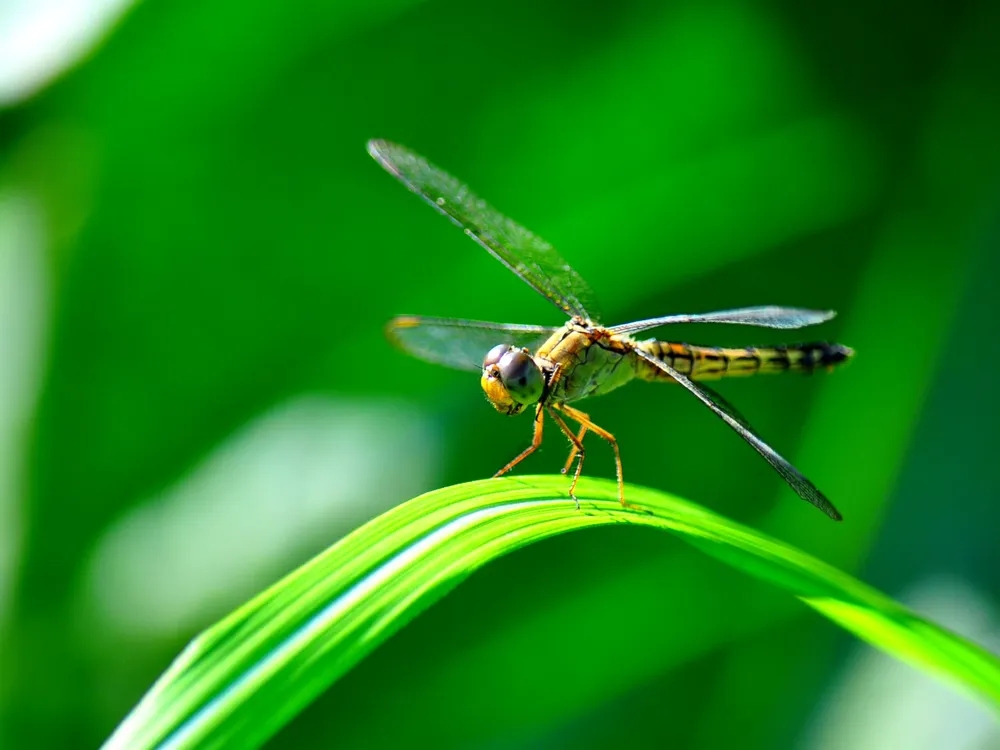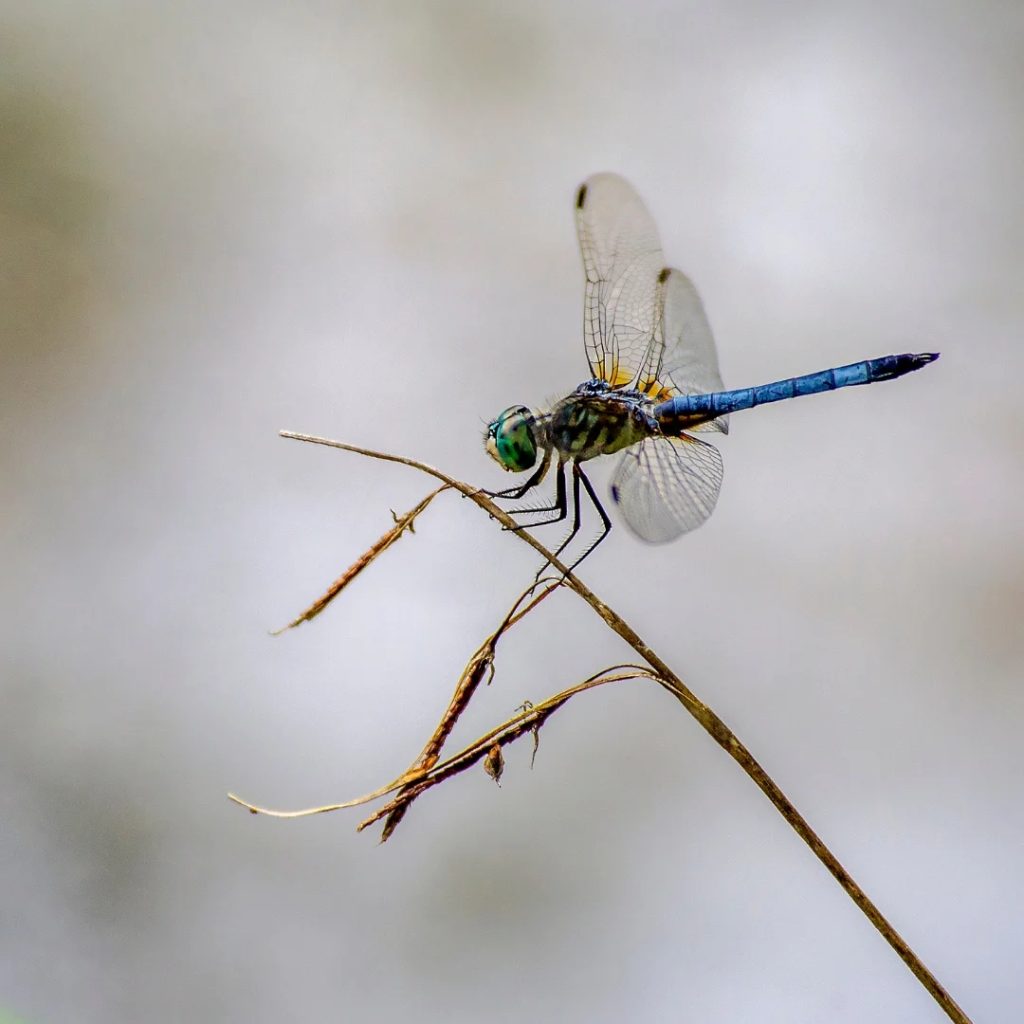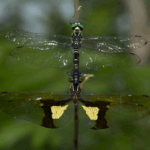From how many species of dragonflies exist in the world to the unique way they breathe, discover all you need to know about dragonflies.
Amazing Dragonfly Facts
Dragonflies are a staple of summer. Their brightly colored bodies dot the warm breeze with all the colors of the rainbow; their stained-glass wings are marvelous to behold. But while you know when you’ve spotted a dragonfly, there’s plenty you might not know about these pretty mosquito-eaters. Here’s a collection of dragonfly facts to bulk up your knowledge about these beneficial insects.

Marvel at the beauty of dragonflies with these dazzling dragonfly photos.
Dragonflies Fly Faster Than You Think
While they might be letting the breeze carry them when you spot one, dragonflies can move pretty quickly when they need to. Two pairs of transparent wings propel them forward as fast as 35 miles per hour.
How fast do hummingbirds fly and flap their wings?
Dragonfly vs Damselfly
You can tell the difference between a dragonfly and a damselfly by looking at their wings. Dragonfly wings point away from the bodies when at rest.
Learn fascinating caterpillar facts you should know.
Dragonflies Are Always Seeing the Sights
Dragonflies aren’t very big, so it takes some serious maneuvering to keep from flying into things. They use over 80% of their brain power to interpret what they see.
Learn how to attract skimmers.
Dragonflies Have Short Antennae for a Reason
While some bugs have long antennae, dragonfly antennae are quite short. There’s a good reason for that — small antennae make it easy for them to get close and bite their prey. To grab larger prey and hold it in midair, dragonflies use their legs.
Don’t miss these pictures that will change how you see bugs.
Dragonflies Breathe in an Unusual Way
This might be the most surprising of our dragonfly facts. You might think these bugs breathe with the same mouth they use to bite their prey…and you would be wrong. Instead of using their mouths, dragonflies breathe through holes in their abdomens.

Discover the bugs you should never kill in your garden.
Dragonflies Are Ancient
Dragonflies have been around a very, very long time. They are some of the oldest animals on the planet, with fossils dating back more than 300 million years.
We found 7 fascinating ladybug facts you didn’t know, and lightning bug facts, too!
There Are Thousands of Types of Dragonflies
Nearly 2,500 different types of dragonflies are found all over the world, in colors from purples to bronzes that often shimmer or look metallic. They lay their eggs and hunt around water, so consider installing a pond to attract them to your backyard.
10 Interesting Facts About Dragonflies

Photo byiannnnnonPixabay
Dragonflies, with their iridescent wings and rapid flight patterns, have long fascinated humans. These ancient insects have been around for over 300 million years and today, there are over 5,000 known species worldwide. Here are 10 intriguing facts about these fascinating creatures.
Dragonflies: Ancient and Remarkable
Dragonflies belong to the Odonata order, derived from the Greek term “odontos” meaning tooth, indicating their serrated teeth. Dragonflies and damselflies, their smaller counterparts, are among the oldest flying insects known to man.
A Glimpse into the Past: The Age of Dragonflies
It’s astounding to realize that dragonflies have been around for at least 300 million years, predating dinosaurs. Fossil records show that prehistoric dragonflies were gigantic, with wingspans reaching up to two feet. Their size is theorized to be due to the high oxygen levels during the Paleozoic era. Today’s dragonflies, however, are much smaller, with wingspans measuring only two to five inches.
Global Presence: Dragonflies Across Continents
Dragonflies are found on every continent except Antarctica. Their wide distribution can be attributed to their ability to adapt to various climates and habitats. From the tropics to temperate regions, dragonflies play a crucial role in local ecosystems.
Dragonflies: Masters of Flight
Dragonflies are renowned for their extraordinary flying abilities. They possess a unique flying mechanism that sets them apart from most other insects.
Incredible Speed and Precision
Dragonflies can reach speeds up to 34 mph, making them one of the fastest insects. They have the ability to fly in any direction – up, down, forward, backward, and even hover in place. This versatility is due to their two pairs of wings which can function independently.
Aerial Predators: Dragonflies on the Hunt
Dragonflies are carnivorous, both as nymphs and adults. Their hunting prowess is remarkable, with a success rate of 95% – higher than that of lions or sharks. Their large compound eyes, encompassing almost their entire head, give them a 360-degree field of vision, aiding in their hunting efficiency.
The Life Cycle of a Dragonfly: From Nymph to Adult
A dragonfly’s life cycle is a fascinating process involving a significant transformation from water-dwelling nymphs to agile, airborne adults.
The Aquatic Phase: The Dragonfly Nymph
Dragonflies spend the majority of their life as nymphs in freshwater bodies. This stage can last for as long as five years, during which they feed on aquatic insects, tadpoles, small fish, and even each other.
Metamorphosis: The Transition to Adulthood
When the time is right, the nymph crawls out of the water and undergoes metamorphosis. The nymph’s skin splits open, revealing the adult dragonfly. The newly emerged adult rests for a short period, allowing its wings to dry and harden before taking its maiden flight.

Dragonflies: Important Players in Ecosystems
Dragonflies play a significant role in freshwater ecosystems. They are both predators and prey, contributing to the balance of their habitats.
Regulating Populations: Dragonflies as Predators
Dragonflies help control mosquito populations, with a single dragonfly capable of consuming hundreds of mosquitoes in a day. This makes them valuable allies in controlling mosquito-borne diseases.
Part of the Food Chain: Dragonflies as Prey
Despite being predators, dragonflies also serve as food for numerous species. Birds, frogs, spiders, and even larger dragonflies are known to prey on them. This dual role as both predator and prey underscores their importance in maintaining ecological balance.
Dragonflies: Long-Distance Travelers
Some species of dragonflies are known to undertake long-distance migrations, exhibiting fascinating behaviors along the way.
Swarm Behavior: The Migratory and Feeding Swarms
Dragonflies are known to form swarms, either for feeding or migration. These swarms can be so large that they are sometimes detected by radar.
The Globe Skimmer: Record-Breaking Migrators
The globe skimmer, or Pantala flavescens, holds the record for the longest dragonfly migration, traversing about 11,000 miles across the Indian Ocean.
Dragonflies: An Inspiration and a Delicacy
Dragonflies have not only awed scientists and nature enthusiasts but have also served as a source of inspiration and a culinary delight in some cultures.
Dragonflies in Engineering: Biomimicry at its Best
The remarkable flight abilities of dragonflies have inspired engineers in designing robots that mimic their flight mechanics. Their ability to fly in all directions, hover, and execute rapid turns is a subject of ongoing research in biomimicry.
A Delicate Treat: Dragonflies in Indonesian Cuisine
In Indonesia, dragonflies are considered a delicacy. They are typically served boiled or fried, offering a taste similar to that of soft-shell crab.
Dragonflies: Indicators of Environmental Health
Dragonflies are excellent bio-indicators, their presence or absence providing valuable insights into the health of an ecosystem.
Environmental Sentinels: Dragonflies and Water Quality
Dragonflies are highly sensitive to changes in water quality, making them reliable indicators of the health of freshwater ecosystems. An abundance of dragonflies usually signifies a healthy water body.
Climate Change Barometers: Dragonflies and Global Warming
The migratory patterns of dragonflies are also being studied as potential indicators of climate change. Changes in their migration routes and timings could provide valuable data on the effects of global warming.
Final Thoughts: The Enigmatic Dragonfly
Dragonflies are truly remarkable creatures. Their ancient lineage, incredible flight abilities, complex life cycle, and crucial role in ecosystems make them a fascinating subject of study. These 10 interesting facts offer just a glimpse into the intricate world of dragonflies, a world that continues to captivate and intrigue scientists and nature lovers alike.






